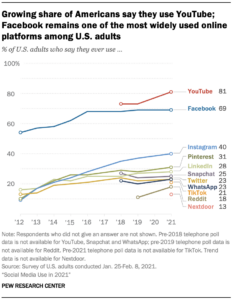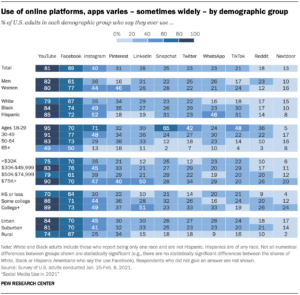When you check your phone notifications in the morning or before bed, where do you start? Most of us will look at our text messages, emails, and a social media platform or two. Does that sound like you?
It’s those social media platform(s) I want you to think about for a moment. How many accounts are you checking? How much time do you spend scrolling, responding to messages, and interacting with content?
And let’s admit it – it’s more than just when we wake up and before we go to bed! How many times a day are you checking those platforms?
It’s no secret that Americans are addicted to social media. Check out this chart from the Pew Research Center, which shows the percentage of U.S. adults who use each social media platform:
As a business owner, you already know that you need to be on social media. But just on this Pew list, there are 11 platforms to consider – and that’s not even including some of the more niche platforms that are gaining traction, such as Clubhouse.
So, where should you spend your hard-earned time and money? What’s the “magic formula” to choosing the right social media platforms for your small business?
The answer is simple: AUDIENCE.
You sell products or services to a specific audience, right? Every once in a while, I hear someone say “my product/service is for anyone!” but that’s just not true. At the end of the day, we all have a target audience that buys the majority of our products and/or services.
So, to determine the right social media platform for you, all you have to do is find out where your audience is hanging out!
Check out this cool chart from the Pew Research Center that breaks down social media usage by age, gender, ethnicity, income level, education level, and even the type of neighborhood they live in.
Print off this chart. Highlight the demographic information that describes your ideal client or customer. If 30%+ of your ideal audience is hanging out on a platform, consider that to be significant for your marketing efforts. And then start creating content on the platform(s) that make the most sense for your business.
These two blogs will help you create a plan, especially part 2:
Why Your Content Marketing Needs to Be Consistent (part 1)
Why Your Content Marketing Needs to Be Consistent (part 2)
One quick caveat: It’s obvious that YouTube is HUGE, across all demographics. But not every organization is set up to easily pump out tons of video content on a regular basis. YouTube watchers are picky about the content they consume and are quick to scroll away if the audio, lighting, or video quality is poor.
That’s why I have the vast majority of my clients start with Facebook and build from there. Facebook might not be the primary way you reach your audience – in fact, it’s only a sales driver for a handful of my clients – but 9 times out of 10, I will recommend at least maintaining a Facebook page for visibility and credibility.
Get 1:1 Help!
Are you feeling overwhelmed with all this information and data? I really want to help you spend your time wisely as a small business owner. Please set up a 15-minute, no-obligation call on my calendar and we can talk about what you’re doing and where you should be spending your time.


